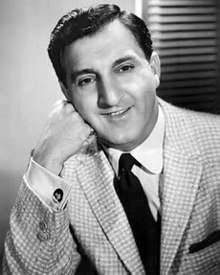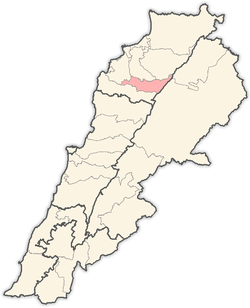Bsharri
| Bsharri بْشَرِّيْ | |
|---|---|
| City | |
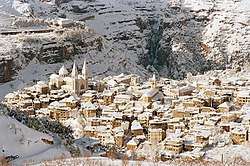 Bsharri under the snow | |
 Bsharri Location within Lebanon | |
| Coordinates: 34°15′4″N 36°0′40″E / 34.25111°N 36.01111°ECoordinates: 34°15′4″N 36°0′40″E / 34.25111°N 36.01111°E | |
| Country |
|
| Governorate | North Governorate |
| District | Bsharri District |
| Elevation | 1,450 m (4,760 ft) |
| Highest elevation | 3,088 m (10,131 ft) |
| Population | |
| • Total | 24,000 |
| Time zone | UTC+2 (EET) |
| • Summer (DST) | UTC+3 (EEST) |
| Dialing code | +961 |
| Website | www.bcharri.gov.lb |
Bsharri (Arabic: بْشَرِّيْ Bšarrī; Syriac-Aramaic: ܒܫܪܝ; also Romanized Becharre, Bcharre, Bsharre) is a town at an altitude of about 1,450 m (4,760 ft) to 3,088 m (10,131 ft). It is located in the Bsharri District of the North Governorate in Lebanon.

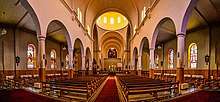
Bsharri is the town of the only remaining and preserved original Cedars of Lebanon (Cedrus libani), and is the birthplace of the famous poet, painter and sculptor Khalil Gibran who now has a museum in the town to honour him.
The site of the Holy Kadisha Valley shelters some of the most ancient Christian monastic communities of the Middle East, and Qurnat as Sawdā Mountain in Bsharri is the highest peak in the Levant, at 3,088 meters above sea level.
Moreover, Bsharri is home to the oldest skiing area, the Cedars Ski Resort, and to Lebanon’s first ski lift, built in 1953. The resort is about a two-hour drive and 130 km (81 mi) from Beirut.
A true heritage of the Christian culture in the Middle East, the town has also the biggest cathedral in the region, the Saint Saba Cathedral, built by Anthony II Peter Arida, in addition to being called "the city of churches" since it houses some 37 churches.
Two UNESCO World Heritage Sites In Bsharri
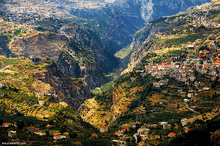
1 Kadisha Valley 2 Cedars of God
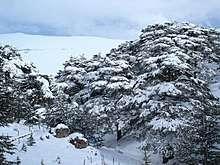

Ouadi Qadisha is one of the most important settlement sites of the first Christian monasteries in the world, and its monasteries, many of which of great age, are set in an extraordinarily rugged landscape. Nearby are the vestiges of the great cedar forest of Lebanon, highly prized in ancient times for the construction of great religious buildings. The Qadisha Valley site and the Forest of the Cedars of God (Horsh Arz el-Rab) are located in Bsharri Lebanon. The Qadisha Valley is located in Bsharri at the foot of Mount al-Makmel and West of the Forest of the Cedars of God. The Holy River Qadisha, celebrated in the Scriptures, runs through the Valley. The Forest of the Cedars of God is located on Mount Makmel, between 1900 and 2050 m The rocky cliffs of the Qadisha Valley have served over centuries as a place for meditation and refuge. The Valley comprises the largest number of monasteries and hermitages dating back to the very first spread of Christianity. The main monasteries are those of St Anthony of Quzhayya, Our Lady of Hauqqa, Qannubin and Mar Lichaa. This Valley bears unique witness to the very centre of Maronite eremitism. Its natural caves, carved into the hillsides - almost inaccessible - and decorated with frescoes testifying to an architecture specifically conceived for the spiritual and vital needs of an austere life. There exist numerous terraces for growing grain by the monks, hermits and peasants who lived in the region; several of these terraces are still under cultivation today. Linked to the Qadisha Valley through historic reference and contiguity, the Forest of the Cedars of God is the last vestige of antique forests and one of the rare sites where the Cedrus lebani still grows, one of the most valued construction materials in the antique world and cited 103 times in the Bible. Criterion (iii): Since the beginnings of Christianity, the Qadisha Valley has given shelter to monastic communities. The trees of the cedar forest are the survivors of a sacred forest and one of the most prized building materials in ancient times. Criterion (iv): The rugged Valley has long been a place of meditation and refuge. It comprises an exceptional number of coenobite and eremitic monastic foundations, some of which date back to a very ancient period of the expansion of Christianity. The monasteries of the Qadisha Valley are among the most significant surviving examples of the strength of the Christian faith.
History
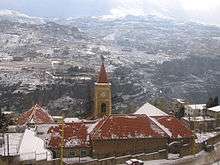
The name Bsharri (بشرّي) can be found in the Phoenician language Bet Ishtar meaning "The House Of Ishtar",[1] Ishtar being a goddess worshipped by the Phoenicians (and King Sulaymān) before Christianity was adopted in the area.

Bsharri was the site of a Phoenician settlement in ancient times. Maronite Christians fleeing persecution sought refuge in its mountainous terrain in the 7th Century AD. The Kadisha Valley, below the town, became the spiritual center of the Maronite Church. The town was known as Buissera by the Crusades.

In Lebanon, Bsharri natives are characterized as very courageous and tribal. They are known across the northern region for their hospitality and patriotism. They are especially known for their distinct accent when they speak Lebanese Arabic. Unlike other parts of Lebanon, Aramaic was spoken in Bsharri well into the 19th century. As a result, Bsharri natives developed an unmistakably strong accent which lasts to this day. There are seven main families in Bsharri: Tawk, Chidiac, Fakhri, Geagea, Kairouz, Succar, and Rahme. Other families are Arida, Choueiri, Shebaya and Boutros.
During the Lebanese civil war (1975–1990), Bsharri was a bastion of Christian resistance against the Palestinians and the Syrians. Many of its youth joined the Lebanese Phalanges at the start of the civil war. In 1986 Samir Geagea, a Bsharri native, became head of the Lebanese Forces (LF) militia (now a political party). Many LF militants were drawn from the town during the civil war. Bsharri natives are often referred to as defenders of the Maronite Christianity in Lebanon.
Unlike most of the other villages around, Bsharri is continuously inhabited during all the months of the year. That is why, even in the coldest days of winter, one can still find open shops to purchase their everyday needs.
Historic names from Bsharri

Gibran Khalil Gibran Khalil Gibran sometimes spelled Kahlil; full Arabic name Gibran Khalil Gibran (Arabic: جبران خليل جبران / Jubrān Khalīl Jubrān or Jibrān Khalīl Jibrān) (January 6, 1883 – April 10, 1931) was a Lebanese writer, poet and visual artist Gibran was born in the town of Bsharri in the Mount Lebanon Mutasarrifate, Ottoman Empire (modern day Lebanon), to Khalil Gibran and Kamila Gibran (Rahmeh). As a young man Gibran emigrated with his family to the United States, where he studied art and began his literary career, writing in both English and Arabic. In the Arab world, Gibran is regarded as a literary and political rebel. His romantic style was at the heart of a renaissance in modern Arabic literature, especially prose poetry, breaking away from the classical school. In Lebanon, he is still celebrated as a literary hero. A member of the New York Pen League, he is chiefly known in the English-speaking world for his 1923 book The Prophet, an early example of inspirational fiction including a series of philosophical essays written in poetic English prose. The book sold well despite a cool critical reception, gaining popularity in the 1930s and again especially in the 1960s counterculture. Gibran is the third best-selling poet of all time, behind Shakespeare and Laozi.
Anthony Peter Arida patriarch of Antioch of the Maronites
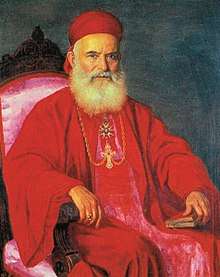
was born in Bsharri, Lebanon on February 2, 1863. He learned Arabic and Syriac languages during his schooldays. From 1884 to 1890 he studied theology at the school of Saint-Sulpice, Paris. He was ordinated priest on September 28, 1890 and served as secretary and canon lawyer of the Maronite Patriarch John Peter El Hajj. On July 31, 1905 Arida was appointed by Pope Pius X honorary prelate. He was appointed Maronite bishop of Tripoli, Lebanon in June 7, 1908 and consecrated bishop on June 18, 1908 by Maronite Patriarch of Antioch, Elias Peter Hoayek, being installed on his episcopal see on June 28 of the same year. Anthony Peter Arida was elected patriarch of Antioch of the Maronites on January 8, 1932 and the Holy See confirmed him patriarch on March 13, 1933. Patriarch Arida openly condemned the treatment of Jews in Germany in 1933. He sustained the Lebanese independence in 1943 in order to maintain the specificity of Lebanon as a Christian nation into a Muslim world. In the last years of his life he was joined in the management and administration of the Patriarchate by a committee of three bishops, including his successor, Paul Peter Meouchi. He died on May 19, 1955 in the Maronite Catholic Patriarchate in Bkerké, Lebanon.
Danny Thomas Kayrouz One of 10 children, Danny Thomas was born as Amos Muzyad Yakhoob Kairouz on January 6, 1912, in Deerfield, Michigan, to Charles Yakhoob Kairouz and his wife Margaret Taouk.[3] His parents were Maronite Catholic immigrants from Lebanon.[4] Kairouz and Taouk are two prominent families from Bsharri. Thomas was raised in Toledo, Ohio, attending St. Francis de Sales Church (Roman Catholic), Woodward High School, and finally the University of Toledo, where he was a member of Tau Kappa Epsilon fraternity.[5] Thomas was confirmed in the Catholic Church by the bishop of Toledo, Samuel Stritch. Stritch, a native of Tennessee, was a lifelong spiritual advisor for Thomas, and advised him to locate the St. Jude Hospital in Memphis.[6][7] He married Rose Marie Cassaniti in 1936, a week after his 24th birthday.
Radio
Thomas first reached mass audiences on network radio in the 1940s playing shifty brother-in-law Amos in The Bickersons, which began as sketches on the music-comedy show Drene Time, starring Don Ameche and Frances Langford. Thomas also portrayed himself as a scatterbrained Lothario on this show. His other network radio work included a stint as Jerry Dingle the postman on Fanny Brice's The Baby Snooks Show. In the early 1950s he made several appearances on the popular NBC variety program, The Big Show, hosted by stage legend Tallulah Bankhead.
Thomas also had his own radio program, The Danny Thomas Show. The 30-minute weekly variety show was on ABC in 1942-43 and on CBS in 1947-48. Films After his two late 1940s films with Margaret O'Brien, Thomas appeared with Betty Grable in the musical Call Me Mister (1951). He then starred in The Jazz Singer opposite the popular contemporary vocalist Peggy Lee, a 1952 remake of the 1927 original. He also portrayed songwriter Gus Kahn opposite Doris Day in the 1951 film biography I'll See You in My Dreams. Music In 1952, Thomas recorded several Arabic folk songs with Toufic Barham for a Saint Jude Hospital Foundation fundraiser record. The songs later appeared on the re-issue album The Music of Arab-Americans: A Retrospective Collection. From 1952 through 1974, Thomas also recorded a number of vocal albums on his own, as well as participating on other albums.
St. Jude Children's Research Hospital As a "starving actor", Thomas had made a vow: If he found success, he would open a shrine dedicated to St. Jude Thaddeus, the patron saint of hopeless causes. Thomas never forgot his promise to St. Jude and, after becoming a successful actor in the early 1950s, his wife joined him and began traveling the United States to help raise funds to build his dream - St. Jude Children’s Research Hospital.[31] He fervently believed “no child should die in the dawn of life.” With help from Dr. Lemuel Diggs and close friend, Anthony Abraham, an auto magnate in Miami, Florida, Thomas founded the St. Jude Children's Research Hospital in Memphis, Tennessee, in 1962. Since its inception, St. Jude has treated children from all 50 states and around the world, continuing the mission of finding cures and saving children. Dr. Peter C. Doherty of St. Jude's Immunology Department, was a co-recipient of the Nobel Prize in Physiology or Medicine in 1996 for key discoveries on how the immune system works to kill virus-infected cells.
Antoine Choueiri Rahme Antoine Choueiri Rahme (August 3, 1939 – March 9, 2010) was a Lebanese media executive. He was the founder of Choueiri Group, the Middle East’s largest media broker. He was born in Beirut in 1939 to a Maronite Christian family from Bcharre and married his wife Rose Salameh in 1961 who gave birth to two children. He died on March 9, 2010 of health complications, he is buried in his ancestral home of Bcharre in his honor one of Bcharre's main streets will be named "Antoine Choueiri" in homage to him and his achievements. Antoine Choueiry Rahme is known as the godfather of Lebanese Basketball because of his heavy investment in the game mostly through his beloved Sagesse Beirut whose phenomenal domination of the newly re-formed Lebanese league and the pan-Arab and FIBA Asian championships took the game to a whole new level which also contributed in the rise of the Lebanese national basketball team
Bsharri Today
Today, the town is located in a highly touristic zone including many attractions such as the Khalil Gibran Museum, the Kadisha Valley, the Kadisha Grotto, the Cedars of God forest and several ski resorts.
Bsharri is home to a Lebanese Red Cross First Aid Center,[2] also to "The Maronite Scouts" that started their activities in early 2000.
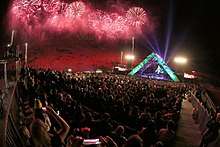
In July 13, 2018, International Colombian singer of Lebanese heritage, Shakira performed in Bsharri during the Cedars International Festival as a part of her 2018 world tour, El Dorado World Tour.
Currently, the District of Bsharri is represented in the Lebanese Parliament by two members, Mrs. Sethrida Tawk Geagea and Mr. Elie Kayrouz, both of them being from the Town of Bsharri and members of the Lebanese Forces political party.
Bsharri natives are also known for their strong Christian faith. Throughout the year, many religious festivities and commemorations take place in the town attracting thousands from neighbouring villages.
Cedars ski resort Bsharri
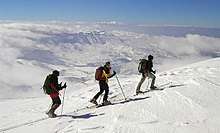
This is a great resort for nature lovers and an ideal get-away destination. The Cedars are the ancient trees forming a forest in the heart of the village and a cedar tree is also found on the Lebanese flag. The Cedars resort is located in the North of Lebanon. Skiers came to the resort as early as 1920, and have been returning there ever since. The first lift was installed by the government in 1953.
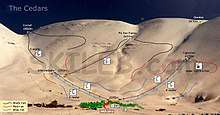
the Cedars resort has a slightly longer season than the others, sometimes beginning early November and often lasting until late April. The Cedars is very different. The resort is beautiful and the lifts are in a huge basin. Several chairlifts could take you to the very top of the mountain for off-piste skiing or down-hill thrills. For beginners, the Cedars is paradise, offering several snow-wire lifts on gently slopes. An alternative suggestion is to practice cross-country skiing which is unmatched at the Cedars, mainly because of the charming surroundings and nature. Skidoo trips are also a common practice at the resort.
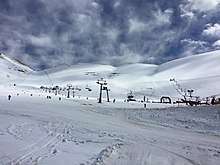
We recommend seeing this resort, because of the big variety of après-ski activities. In addition to the Cedars forest, there are numerous sites of interest in the area. Bsharri, its the village of the Cedars, is the birthplace and resting place of Gibran Khalil Gibran, Lebanon's most famous poet, artist and novelist. The Gibran museum houses his paintings, drawings and personal effects. There is a number of Maronite churches and monasteries scattered throughout the mystic Kadisha valley.
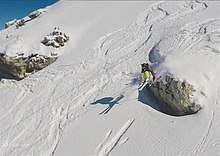
In summer 2005, The Cedars resort installed 3 new chairlifts to replace the old T-bars and extend the ski runs. 15 million US Dollars have lately been invested to upgrade the facilities and expand the resort to higher standard of in terms of accommodation, equipment, safety, and services.
A Gondola for 6 persons will carry skiers and visitors from the parking level at 2095m to the highest accessible summet of 2870m, however there's no indication yet of when will this be completed. To comply with international regulations, a Refuge with a capacity of 400 persons will also be built at the top of the Gondola. Its terrace will be equipped with telescopes capable of expanding your sights till the island of Cyprus.
Geography
Climate
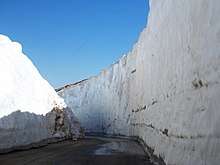
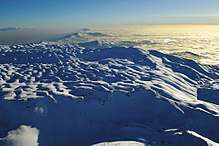
Bsharri has a continental Mediterranean climate (Csb/Dsb, according to the Köppen climate classification), with dry and mild summers and cold, snowy winters. Temperatures in the summer can go above 30 °C (86 °F) a few times per year. On the other hand, temperatures can plummet to −15 °C (5 °F) and in bsahrri mountain can plummetb −30 °C (−22 °F) to on some occasions during the winter. Heavy snowfall is observed every year and accumulations of over 2 m (80 in) and in Bsharri mountain 7 m (280 in) are not unheard of.
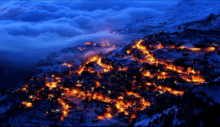
| Climate data for Bsharri | |||||||||||||
|---|---|---|---|---|---|---|---|---|---|---|---|---|---|
| Month | Jan | Feb | Mar | Apr | May | Jun | Jul | Aug | Sep | Oct | Nov | Dec | Year |
| Average high °C (°F) | 4 (39) |
4 (39) |
6 (43) |
11 (52) |
16 (61) |
20 (68) |
22 (72) |
23 (73) |
20 (68) |
16 (61) |
11 (52) |
7 (45) |
13 (56) |
| Daily mean °C (°F) | 0 (32) |
0 (32) |
2 (36) |
7 (45) |
11.5 (52.7) |
15 (59) |
17 (63) |
17.5 (63.5) |
15 (59) |
11.5 (52.7) |
7 (45) |
3.5 (38.3) |
8.9 (48.2) |
| Average low °C (°F) | −4 (25) |
−4 (25) |
−2 (28) |
3 (37) |
7 (45) |
10 (50) |
12 (54) |
12 (54) |
10 (50) |
7 (45) |
3 (37) |
0 (32) |
5 (40) |
| Average precipitation mm (inches) | 221 (8.7) |
166 (6.54) |
127 (5) |
61 (2.4) |
31 (1.22) |
4 (0.16) |
0 (0) |
0 (0) |
6 (0.24) |
39 (1.54) |
97 (3.82) |
172 (6.77) |
924 (36.39) |
| Source: climatetemp.info[3] | |||||||||||||
Gallery
 Bsharri under the snow 2008
Bsharri under the snow 2008.jpg) Kadicha valley
Kadicha valley Bsharri under the night
Bsharri under the night.jpg) Bsharri - Apple Trees (Autumn)
Bsharri - Apple Trees (Autumn).jpg) Bsharri - Alcohol Extraction ('Arak).
Bsharri - Alcohol Extraction ('Arak).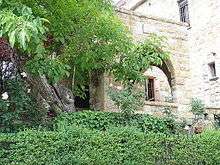 Gibranshome
Gibranshome Bsharri
Bsharri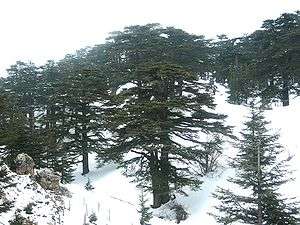 Forest of The cedars of God
Forest of The cedars of God Cedars International Festival
Cedars International Festival Bsharri-Lebanon
Bsharri-Lebanon
- Gibran Museum
See also
References
- ↑ Journée Antonine Archived October 28, 2008, at the Wayback Machine.
- ↑ Our Centers Archived February 12, 2006, at the Wayback Machine.
- ↑ "Climate History for Bsharri, Lebanon". Archived from the original on 3 August 2011. Retrieved 14 November 2011.
